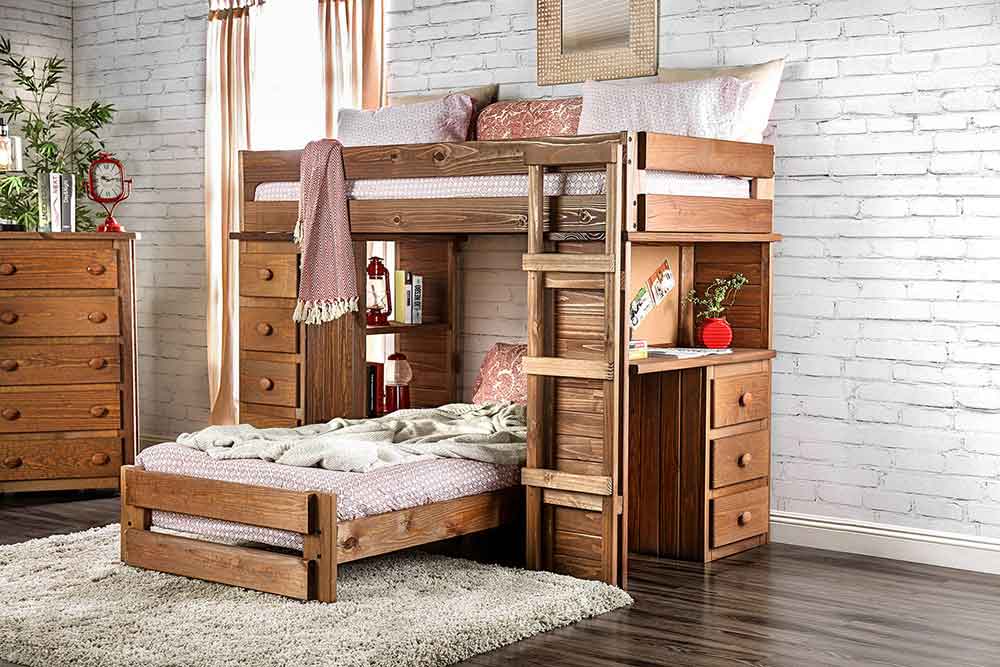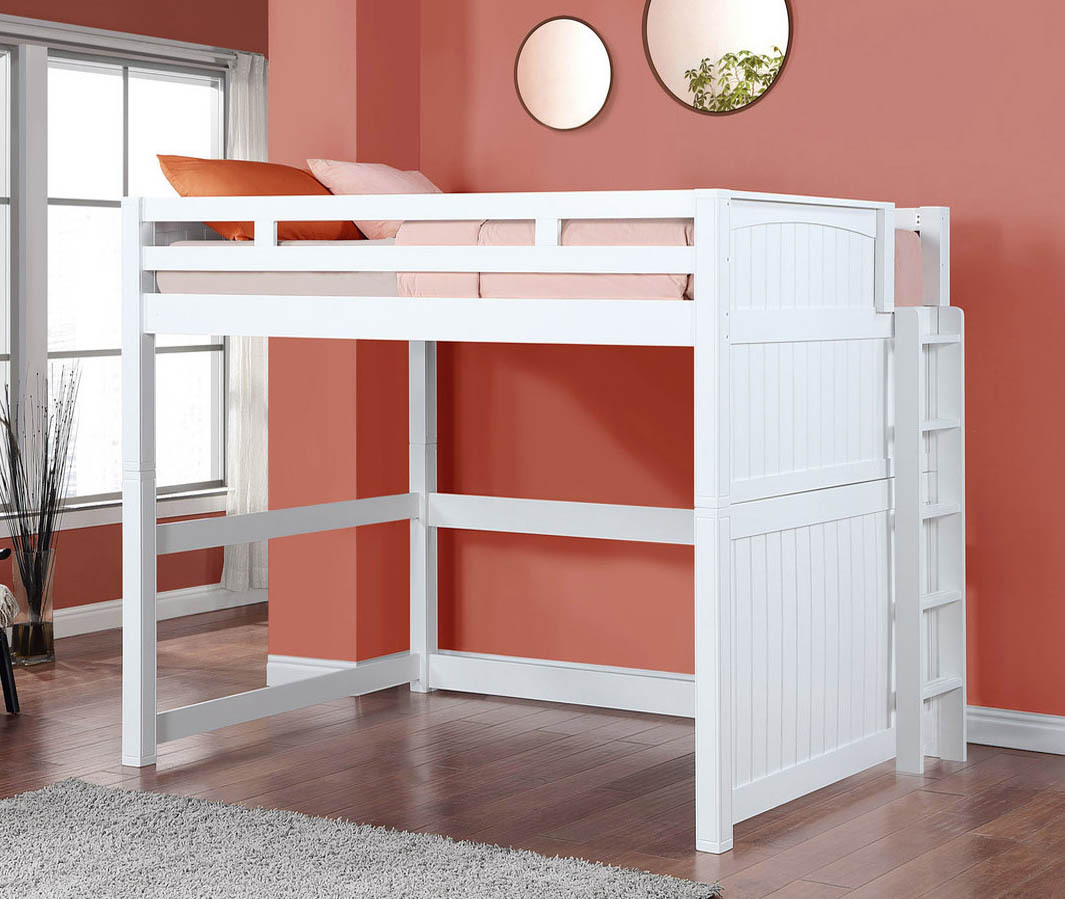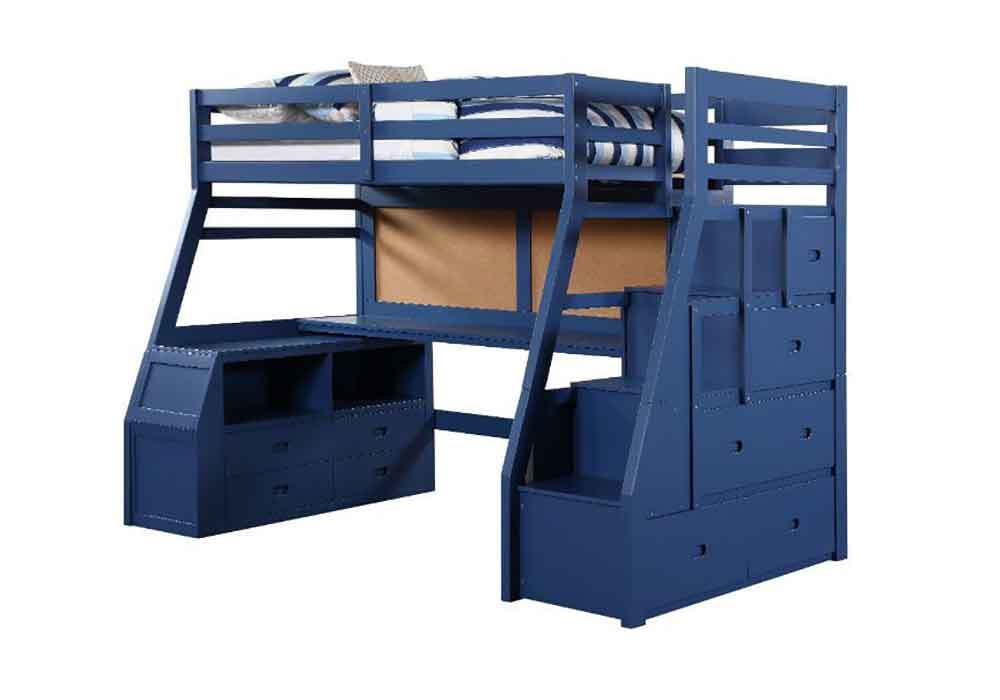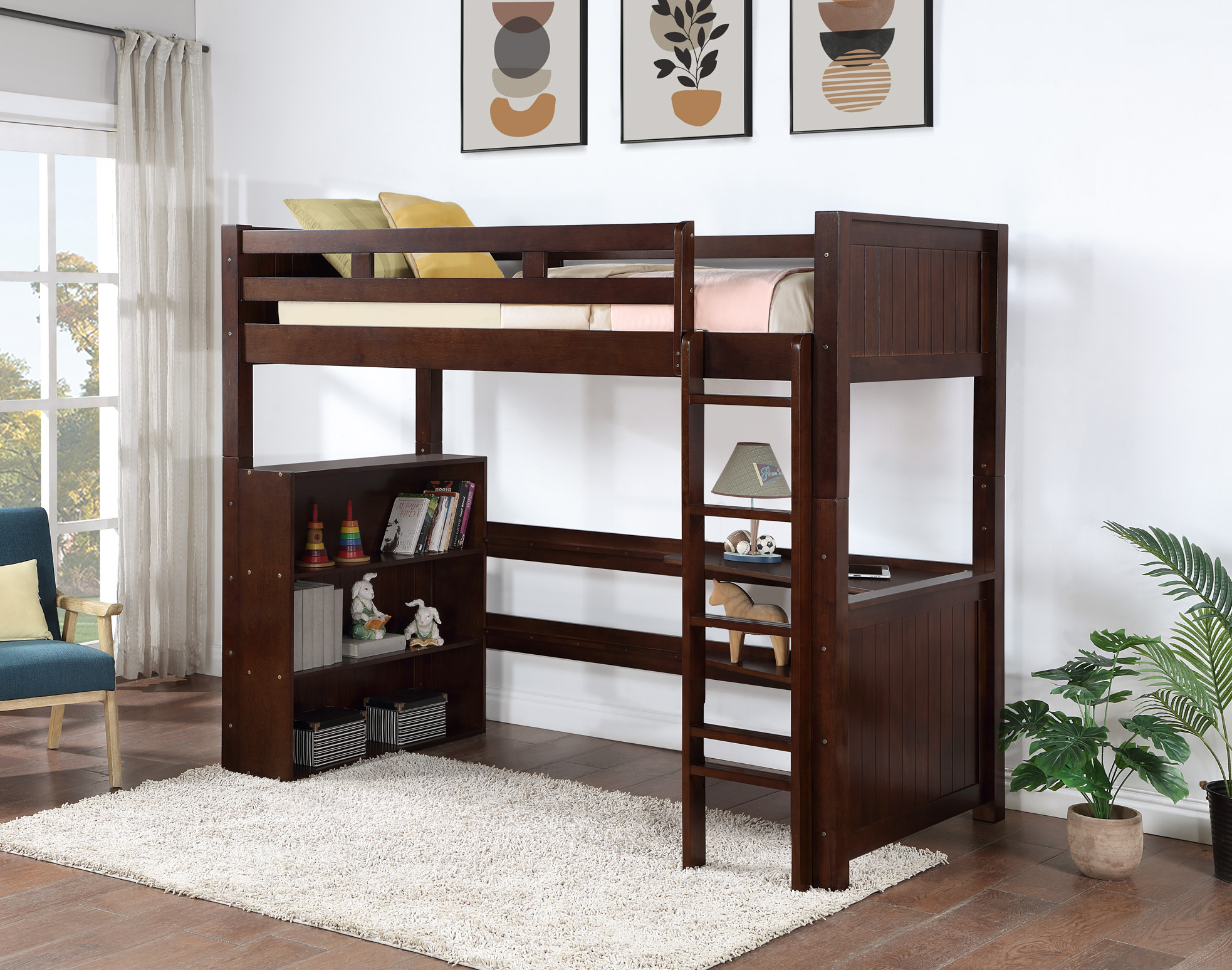How Much Weight Can a Loft Bed Hold?
Posted by UPW on Apr 15th 2025

When you're asleep, you're completely unaware of your surroundings—your body relies entirely on your environment to stay supported and undisturbed. That’s why a stable, secure bed plays such a critical role in achieving meaningful rest, especially for students dealing with long hours of study or professionals unwinding after demanding workdays.
In homes where space is limited and every square foot needs to work harder, loft beds have become a practical and increasingly popular solution. But before choosing one, there’s an important factor to understand: how much weight can a loft bed really hold?
Material and Design: Determining Loft Bed Strength
Loft bed strength depends largely on the material and construction methods used. Solid hardwood options like oak, birch, maple, or Brazilian pine offer excellent structural support, thanks to their dense grain and reliable joinery methods, such as mortise-and-tenon or dovetail joints.
These beds are less prone to flexing and typically hold up well over long-term use, making them a solid choice for setups that include under-bed use, such as storage or a loft bed with a desk. Softer woods or particle board alternatives, by contrast, may show signs of wear more quickly under daily stress.
Metal loft beds with thick-gauge steel or aluminum alloys are known for their strength-to-weight ratio and durability in both residential and commercial settings. Welded joints and powder-coated finishes help reduce movement and minimize long-term flexing.
Engineering and Certification: What Makes a Loft Bed Reliable?
The design of a loft bed isn’t just about appearance, it determines how well the bed holds up under regular use. Reinforced construction, properly spaced support components, and verified testing all contribute to the long-term performance of the frame.
- Support Configuration – Beds with center support beams, full-length guardrails, and evenly spaced slats handle static pressure more efficiently than minimalist frames. These features prevent sagging and reduce stress on connecting joints.
- Reinforced Stair Systems – Loft beds that include built-in stairs instead of ladders often offer enhanced weight distribution and added structural support. The staircase base typically reinforces the side rails, making the entire frame more stable.
- Welded vs. Bolted Frames – Welded metal frames generally offer stronger joints with less movement over time compared to bolted frames, which may loosen without regular tightening.
- Joinery Techniques in Wood Frames – Traditional joinery methods like mortise-and-tenon or dovetail joints provide more integrity than beds that rely solely on screws or metal brackets.
- ASTM International (F1427) – Establishes performance and durability standards for loft and bunk beds, ensuring key elements like load-bearing strength, guardrail height, and durability over repeated use.
- CPSC Guidelines – The Consumer Product Safety Commission provides specific requirements for children’s loft beds, including minimum guardrail heights, slat spacing, and safe access points.
- ANSI/BIFMA Standards – Typically applied in commercial or institutional environments, these guidelines cover the mechanical strength and durability of beds intended for high-use or shared spaces.
Choosing a loft bed that’s engineered for stability and backed by recognized certification standards means you're investing in consistency, not just capacity. These construction details aren’t always visible at a glance, but they influence how the bed performs across years of use, movement, and weight variation. When your furniture is built with verified support in mind, you’re not just buying a product—you’re choosing consistency you won’t have to second-guess.
Can Adults Sleep in Loft Beds?
Yes, adults can absolutely sleep in loft beds as long as the model is specifically rated for adult use. Look for adult loft beds that clearly outline structural specifications and always confirm the weight limit provided by the manufacturer.

Can Two People Sleep Comfortably on a Loft Bed?
Loft beds can accommodate two people comfortably—but only when the bed size and layout are appropriate for shared use. While loft beds are often associated with solo sleepers, many models are designed to meet the needs of couples, roommates, or siblings sharing limited space. Selecting the right size and setup is essential not just for sleep comfort but also for ease of access and uninterrupted rest.
Key factors that make a loft bed suitable for two people:
- Full and Queen Loft Beds - These are the most suitable options for shared sleeping. A full-size loft bed provides enough room for two children or smaller-built adults, while a queen-size loft bed offers more width and length for sleepers who need extra space to move freely at night.
- Sleeping Space vs. Mattress Fit - Pay close attention to the usable surface area—not just the mattress size. Some loft beds frame tightly around the mattress with limited edge clearance, which can reduce overall comfort when two people are sleeping side by side.
- Headroom and Ceiling Clearance - Sharing a loft bed means both sleepers may shift positions or sit up during the night. Beds placed in rooms with low or sloped ceilings can feel restrictive, especially for taller users. Make sure there’s enough headroom above the mattress to sit upright without bumping into the ceiling or overhead fixtures.
- Climbing and Access - If both users need regular access to the loft, a staircase-style entry is often easier to use than a vertical ladder—especially for nighttime use or when carrying bedding and personal items. Models with wider steps and integrated handrails help reduce strain and improve overall usability.
Sharing a loft bed can work well when comfort and practicality are considered from the start. Room layout, mattress dimensions, and ease of access all play a role in determining whether the setup will meet daily needs without compromise. If the bed is expected to accommodate two people long-term, selecting a model that balances size with smart access and movement features is the best way to ensure it remains functional and comfortable over time.

Maintenance Tips to Ensure Loft Bed Safety
Even the most structurally sound loft bed will only perform as well as it's maintained. Daily climbing, seasonal humidity changes, and room rearrangements can all impact the integrity of your loft bed over time.
Whether the bed is used by a child, teen, or adult, a few routine checks can significantly reduce the chance of unexpected issues. The goal is to preserve long-term safety without relying on guesswork or waiting for visible damage.
- Check All Hardware Every 3–4 Months - Use a wrench or Allen key to inspect and tighten bolts, screws, and brackets—especially around the corners of the frame, ladder or staircase joints, and guardrail attachments. These are high-stress areas that loosen gradually with repeated use.
- Inspect Slats for Wear or Cracking - Remove the mattress and check each slat for signs of bowing, hairline cracks, or warping. Slats that flex too easily or show visible damage should be replaced immediately to maintain consistent support across the sleep surface.
- Pay Attention to Movement or Sound - If you notice creaking noises, a subtle sway when climbing, or movement during sleep, stop using the bed until it’s inspected. These symptoms often point to loose fasteners, fatigued materials, or shifting frame components that need realignment or reinforcement.
- Avoid Overloading with Non-Sleep Items - Factor in the combined weight of the sleeper, mattress, and any storage bins or furniture placed beneath or on the loft bed. Hanging items like hammocks or bag hooks from the frame should also be avoided unless the frame is rated for dynamic loads.
- Protect Wood from Moisture and Humidity - Keep wooden loft beds away from humidifiers, open windows, or direct contact with floors prone to moisture. Over time, excess humidity can cause swelling, joint separation, or surface warping—especially in softer woods.
- Recheck Stability After Moves or Reassembly - If the bed has been disassembled for moving or repositioned in the room, check every structural connection again before use. Improperly tightened joints after relocation are a common cause of instability.
Preventive maintenance is the simplest way to extend the life of your loft bed and avoid safety hazards. By setting a regular check-up schedule and staying alert to subtle changes in the bed’s movement or sound, you can help ensure that it stays reliable, stable, and safe for years to come.

Tips for Choosing the Right Loft Bed
Choosing a loft bed isn’t just about making it fit in the room; it’s about selecting a structure that matches the user’s age, body size, daily habits, and how the space will actually be used.
- Match the Bed Size to the User’s Needs - A twin loft bed works well for smaller children or single sleepers. Full-size and queen loft beds are better suited for older teens, adults, or two-person use. Consider future growth if you’re choosing for a pre-teen or young adult.
- Select a Ladder or Staircase That Fits the Room - Ladders work well in narrow layouts but tend to be steeper and less forgiving for frequent use. Staircases offer easier access, especially for younger kids or adults, and often include drawers or shelving built into each step.
- Review Vertical Clearance and Ceiling Height - Measure the room from floor to ceiling to confirm enough headroom above the mattress. Loft beds typically need 30–36 inches of clearance to sit up comfortably, so avoid placing them under sloped ceilings or ceiling fans.
- Look for Integrated or Add-On Storage Features - If storage is a priority, consider loft beds with storage. Some models come with modular add-ons that can be reconfigured as needs change—ideal for kids’ rooms, college housing, or studio apartments.
- Consider Bed Height and Under-Bed Use - Low loft beds are great for younger users and still allow space for storage bins, while high loft beds can fit full workstations, dressers, or even small sofas underneath. Decide how the under-bed space will be used before selecting the height.
- Check Compatibility with Existing Furniture - Measure how the loft bed will interact with windows, doors, closets, and any existing furniture in the room. Ensure there’s enough space to move around the bed, climb in comfortably, and access under-bed storage without obstruction.
The right loft bed should serve both current needs and potential future shifts in lifestyle, layout, or user size. Taking the time to assess room dimensions, movement patterns, and feature preferences will help you make a more reliable and long-lasting choice.
At Just Bunk Beds, we offer loft beds built with both durability and real-life use in mind. Browse our curated selection or contact us directly for expert help choosing the right loft bed for your space and needs — we’re here to make it simple.

